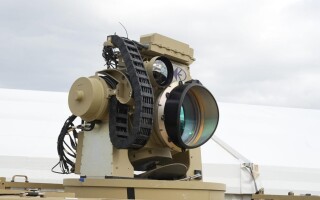Too cool
StoryDecember 14, 2010
New patent-pending CoolWall chassis sandwiches alloys and takes the heat beyond the competition.
It’s the bane of VME and military system designers: SWaP. These three vectors – Size, Weight, and Power – are what designers optimize for day in and day out. With Core i7 quad-core CPUs or AltiVec engines showing back up in Freescale CPUs, dissipating processor heat off of VME or VPX LRUs is problematic. Curtiss-Wright Controls, Electronic Systems (what I’ll call CWCES) has just announced a patent-pending breakthrough that promises 2-3x more power dissipation in the same chassis.
Called CoolWall Thermal Management Technology and implemented in the company’s SFF-6 small ATR for 3U OpenVPX or CompactPCI, the equivalent chassis using CoolWall exhibits a 2.4x decrease in sidewall temperature due to an equivalent increase in metallic conductivity. At the chassis wedgelock rails, CWCES claims a 67 W/slot power dissipation in the 6/7 slot (OpenVPX/CompactPCI) chassis. And this is their first generation; next-gen gains are expected to be 3x decrease versus the standard Aluminum alloys used in today’s military chassis.
Did CWCES discover some new alloy? Did they intermix nanoparticles with Al and achieve a miracle? Is this a liquid-cooled box or did they bury heat pipes next to the hottest components? The answer is “no” in all cases. Military designers don’t like the possibility that heat pipes may leak and spill their metallic salts onto LRUs to cause shorting or corrosion, and liquid-cooled chassis are saved for only those situations that absolutely need in excess of 100 W/slot. Nanoparticles are being used to achieve amazing liquid conductivity, though that technology is still in the DARPA stages.
The typical 6U VME box dissipates 20-30 W/slot - the same for a 3U OpenVPX chassis (due to the inherently higher power CPUs and gigabit transceivers found on the latest 3U boards). So achieving 67 W/slot is pretty remarkable. How is it done? Although CWCES considers this proprietary and is scant on details, they did reveal that they’ve created a “sandwich” using two different Al alloys with a closely coupled mechanical bond between them (see author’s drawing). The combination of the two materials – instead of just one layer of Al alloy – achieves appropriate strength, 2-3x better thermal conductivity, and a 10-20 percent weight reduction for the equivalent chassis design.
When asked about that metal-to-metal bond, Bob Sullivan, CTO at CWCES’s packaging division in Littleton, MA (and formerly of Hybricon, which Curtiss-Wright purchased last year), assured me that the TCE (coefficient of thermal expansion) between the metals is minimal because they are so similar, and the possibility of creep or electromigration or other intermetallic nasties is minimal due to the materials. As well, outgassing or corrosion problems (when the chassis is in a high-humidity or salt/fog environment) are eliminated because the whole sandwich is Nickel coated and effectively sealed.
What’s the price for this not-so-exotic material that achieves such high conductivity? CWCES hasn’t released prices, but says it’s a 10-20 percent premium over the equivalent Al chassis. While equivalent thermal gains could be achieved with a completely all-copper chassis, CoolWall is dramatically cheaper and lighter. Today, CoolWall is 1.2x lighter than Cu; in the next incarnation, it’ll be 1.5x lighter.
Interesting, CoolWall has lots of headroom for increased conductivity (Figure 1). The numbers cited are for only some of the chassis constructed with CoolWall; making the entire chassis out of the material ought to improve the heat dissipation. As well, the LRUs themselves could use CoolWall for the heat frame and/or wedgelock interfaces, allowing even more per-card heat dissipation. (But the chassis would need to be scaled up accordingly.) Versus conventional all-Al chassis that must maintain a 71 ?C baseplate and 85 ?C card edge, CoolWall could do even better by increasing the baseplate temperature or the environmental constraint. The point is: Moving the boundary conditions around is possible because the material allows designers to optimize for the systems’ key vectors: size, weight, and power (along with cost).
Figure 1: The author’s representative hand-drawn graphic of Curtiss-Wright’s CoolWall technology.
Chris can be contacted at [email protected].





